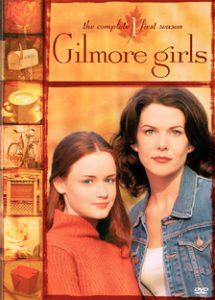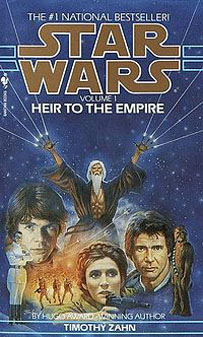I was able to find last year’s 20th anniversary edition of “Heir to the Empire” for about six bucks, so it gave me a perfect excuse to re-read it. I wrote about my memories surrounding the book last year, so for this post I’ll dig more into my impressions from re-reading it.
Timothy Zahn’s “Heir” (1991) — released a mere eight years after “Return of the Jedi,” although those were a long eight years when I was a kid — expands exponentially on what had come before. The seven Expanded Universe novels that predated it (“Splinter of the Mind’s Eye” and the “Han Solo” and “Lando Calrissian Adventures”) focused on one character or small group, and tiny new corners of the galaxy; “Heir” blew things up with its epicness spanning a dozen planets — old and new — and a dozen major characters — both the classics, with Zahn absolutely nailing their voices (especially Han’s), and soon-to-be favorites.
On the other hand, in the more than 100 “Star Wars” books that have followed “Heir’s” release, many have been notably superior. I attribute that in part to those authors standing on the shoulders of the giant that is Zahn. He made it OK to fully delve into “Star Wars” with a galaxy-spanning clash between Grand Admiral Thrawn’s resurgent Empire and the fledgling New Republic, while also adding his own touches — the chess-like military strategies of Thrawn being a prime example.
Authors like Kevin J. Anderson (the Jedi Academy), Michael Stackpole (Rogue Squadron), Karen Traviss (clone troopers), Michael Reaves (the Coruscant underworld) and John Jackson Miller (the Lost Tribe of the Sith) have since carved out niches within the wider narrative, and that allows them to go into a level of detail that “Star Wars” fans eat up. However, I’d argue that no one has written a better galaxy-spanning narrative than Zahn.
In part, it’s because he got there first. Quality of writing aside, it was cool simply to read about (and envision in my mind’s eye, and later in the comic adaptations) Luke, Han and Leia out and about on important missions. Zahn’s words bring to life old planets like Dagobah — where Luke is drawn to the famous cave by a shimmer in the Force — and new locales like Kashyyyk, with its cities in the treetops (Zahn’s vision, befitting a Ralph McQuarrie painting, blows away the planetside Kashyyyk we saw in “Revenge of the Sith”). The scene of Leia and Chewie dodging an assassin by crawling among the branches on the underside of Rwookrrorro might be the book’s coolest.
Three new characters stand out:
- Thrawn, in addition to his uncanny knack for boiling war into a series of strategic moves, is also distinct from Vader and the Emperor in that he earns the respect of his underlings rather than their fear (although there is one somewhat odd scene where he executes a bumbling officer, almost as if Zahn decided he needed to remind readers than Thrawn is indeed the bad guy).
- Mara Jade is a mysterious character at first, because we know she wants to kill Luke. Finally, she reveals that she was once the Emperor’s Hand and that Luke’s dispatching of the Emperor stripped her life of meaning. I had recalled Luke and Mara’s adventure in the Myrkr forests as being longer; indeed, the whole novel seemed less sprawling to me on this re-reading, giving me an appreciation of Zahn’s skill for writing concisely without sacrificing the reader’s ability to get lost in his world. On a side note, I don’t envision Mara and Luke as a future couple when I re-read “Heir”; Zahn doesn’t tip his hand here.
- Talon Karrde is the best Zahn creation, though. Although we had gotten hints of that gray area of “Star Wars” through Han’s and Lando’s backstories and the truncated arc of Boba Fett in the films, Karrde takes things to a new level with the way he operates outside the boundaries of Republic and Empire, trading supplies and information. It’s fascinating that the ever-honorable Karrde protects Han and Lando simply because they are his guests, even if it earns him the wrath of Thrawn and forces him to leave his comfortable home on Myrkr.
Zahn gave “Star Wars” a new dimension when he added politics into the mix. Although not as overt as in the prequel films and “Clone Wars” or the sprawling series of the 2000s (“New Jedi Order,” “Legacy of the Force” and “Fate of the Jedi”), “Heir” sets up political intrigue for the rest of the Thrawn trilogy with a cliffhanger that finds Ackbar deposed as the head of the Republic in favor of a scheming Bothan upstart, Fey’lya.

The annotations in the 20th anniversary edition by Zahn and editor Betsy Mitchell are a treat. Although I would’ve liked more of Zahn’s reflections on “Star Wars” at large, he does provide insight into the structuring of the plot — he originally ended the book with the Hyllyard City battle, when Luke drops an archway on the Empire’s forces, rather than with the battle at Sluis Van, where Thrawn employs mole miners stolen from Lando to steal a bunch of ships. Zahn also raises a curtain on the struggles of the editing process — he notes that a line editor, obviously not a “Star Wars” fan, changed every “stormtrooper” to “storm trooper.” And he’s not too egotistical to highlight his own mistakes: When Mara first picks up Luke’s lightsaber, she reflects on her unfamiliarity with the weapon, something that would be contradicted not just as we learned more about her, but even in “Heir” itself. Woops.
These annotations demystify “Heir” somewhat, but that’s a fair tradeoff, similar to how I’ve always enjoyed learning about the making of the “Star Wars” movies as much as the movies themselves.
The 20th anniversary edition wraps with a new Zahn novella, “Crisis of Faith,” which shows Thrawn engaged in a military chess match with a warlord in the Unknown Regions a bit before the events of “Heir.” I couldn’t get into this story, as it lacks the wider galactic context; the only major players I recognized were Thrawn and TIE pilot Soontir Fel, who is more fully explored in an issue of Stackpole’s “Rogue Squadron” comic series.
But “Heir to the Empire” is a page-turner even on repeat readings, and that’s ultimately what gives it a comfortable kinship with the films, which fans find to be notoriously re-watchable. Now I find myself looking forward to re-reading “Dark Force Rising” — itself celebrating its 20th anniversary this year, although, sadly, there will be no annotated edition — to unravel all of Zahn’s storytelling threads yet again, as if for the first time.

